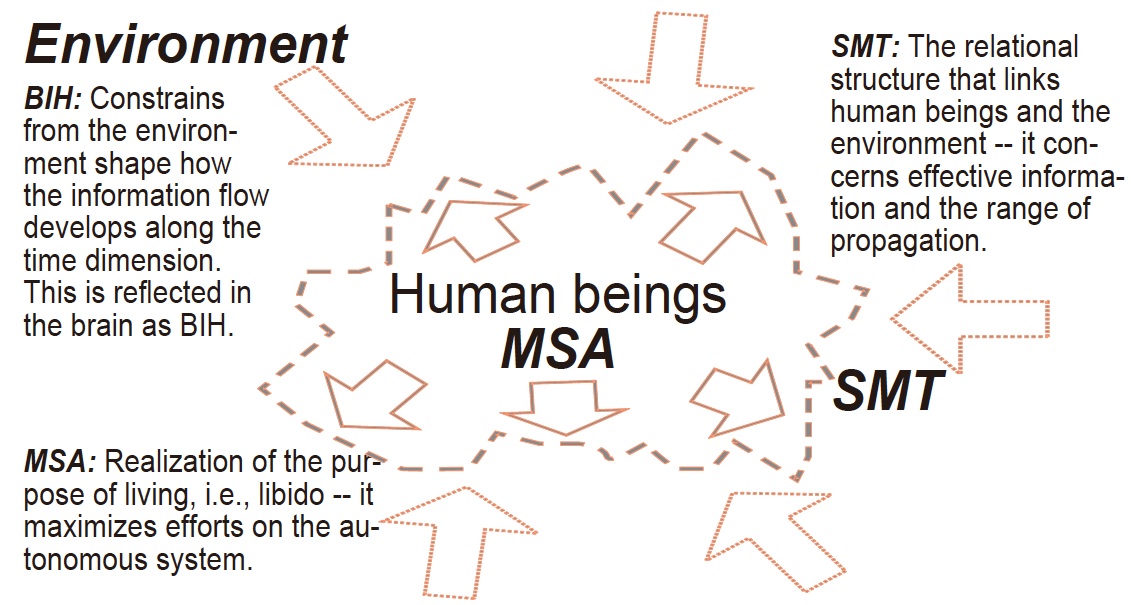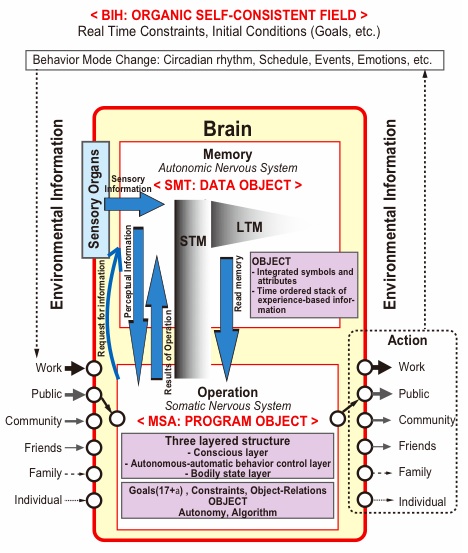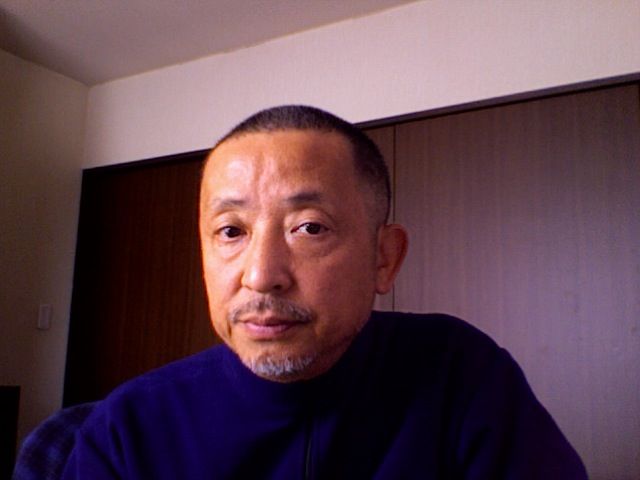Organic Self-Consistent Field Theory:
Toyota-Kitajima Brain Model
Toyota-Kitajima Brain Model
« Topics »
» Awards (International)
- COGNITIVE2025 (Best Paper Award): Implementation of Structured Memes into Behavioral Ecology via GOMS -- (Kitajima, M., Toyota, M., Dinet, J., and Nakahira, K.T.)
... pdf - AIVR 2025 (Invited for IARIA Journals): Addressing the Symbol Grounding Problem in VR -- (Kitajima, M., Toyota, M., and Nakahira, K.T.)
... pdf - COGNITIVE2024 (Invited for IARIA Journals): Practice Stages for a Proficient Piano Player to Complete a Piece:Understanding the Process based on Two Minds-- (Katsuko T. Nakahira, Muneo Kitajima, Makoto Toyota)
... pdf - AIVR2024 (Invited for IARIA Journals): Model-Based Analysis of the Differences in Sensory Perception between Real and Virtual Space : Toward “Adaptive Virtual Reality”-- (Taichi Nakagawa, Muneo Kitajima, Katsuko T. Nakahira)
... pdf - COGNITIVE2023 (Invited for IARIA Journals): Local-Global Reaction Map: Classification of Listeners by Pupil Response Characteristics when Listening to Sentences Including Emotion Induction Words -- Toward Adaptive Design of Auditory Information -- (Katsuko Nakahira T., Munenori Harada, Muneo Kitajima)
... pdf - COGNITIVE2022 (Invited for IARIA Journals): Guidelines for Designing Interactions Between Autonomous Artificial Systems and Human Beings (Muneo Kitajima, Makoto Toyota, Jerome Dinet)
... pdf - COGNITIVE2021 (Invited for IARIA Journals): The Role of Resonance in the Development and Propagation of Memes (Muneo Kitajima, Makoto Toyota, Jerome Dinet)
... pdf - COGNITIVE2020 (Invited for IARIA Journals): The Concept of Resonance: From Physics to Cognitive Psychology (Jerome Dinet, Muneo Kitajima)
... pdf - HUCAPP2020 (Best Poster Award): How Auditory Information Presentation Timings Affect Memory When Watching Omnidirectional Movie with Audio Guide (Rinki Hirabayashi, Motoki Shino, Katsuko N. T. and Muneo Kitajima)
... html - The Best Research Paper Award: - 5th World Conference for Graduate Research in Tourism, Hospitality and Leisure 2010: A Cognitive Chrono-Ethnography Study of Visitors to a Hot Spring Resort, Kinosaki-onsen (Muneo Kitajima, Hirotsugu Tahira, and Sachi Takahashi)
... html
» Awards (Domestic - in Japan)
- 情報科学技術フォーラム FIT2019(ヤングリサーチャー賞): 鑑賞行動における記憶促進のための音声ガイド呈示タイミング (平林輪樹, 小竹元基, 中平勝子, 北島宗雄)
... html - 情報処理学会(山下記念研究賞, 2016): 円滑なコミュニケーション形成支援を目的とした符号化・記述手法 (後藤義貴, 中平勝子, 北島宗雄)
... html - 人間工学会(大島正光賞, 2008): 高齢者を対象とした駅の案内表示のユーザビリティ調査:認知機能低下と駅内移動行動の関係の分析 (北島宗雄, 熊田孝恒, 小木元, 赤松幹之, 田平博嗣, 山崎博)
... html - 日本認知心理学会(優秀発表賞, 2005): ユーザビリティ評価のための高齢者の注意・遂行機能評価テストの作成 (熊田孝恒, 北島宗雄, 小木元, 赤松幹之, 山崎博)
... html
» International Contributions
M. Kitajima participated in the OECD working group to develop the content of the second phase of the PIAAC (The Programme for the International Assessment of Adult Competencies) survey. The MHP/RT was adopted as the basis for capturing adaptive problem-solving skills, which are skills needed for employment. The results of the working group were published by the OECD in a report entitled "Adaptive problem solving Moving toward a new assessment domain in the second cycle of PIAAC".
» » » » » » « « « « « «
» Presentation at The Second International Conference on Artificial Intelligence and Immersive Virtual Reality: AIVR 2025:
Comment by Makoto Toyota -- This paper explains that the symbol grounding problem, which is an expression that represents the limitations of language processing-based AI, which has recently become popular, has a similar problem in symbols in VR environments such as the metaverse. Professor Hiroshi Ishii of MIT Media Lab also mentioned this problem (MIT Professor Ishii "The sense of tension and trust in reality cannot be reproduced in the metaverse"). From the point of view of cognitive science, this paper explains the problem as the mechanism of the brain. -- 7-April-2025
» Presentation at The Seventeenth International Conference on Advanced Cognitive Technologies and Applications: COGNITIVE 2025:
Comment by Makoto Toyota -- This paper is the last piece in the development of the Toyota-Kitajima Brain Model, which Kitajima and I have been studying for more than 20 years, to understand human behavior from the mechanism of the brain. The content describes the methodology of analysis to understand the overall picture of the collective behavioral ecology, the structural origin of the constructed memes and the method of deciphering it from the structure of memes. I feel fortunate that I was able to work on the very large-scale problem of the human brain and the elucidation of the action selection process generated from it, and to be able to build and complete it with a unique theoretical framework. However, due to the limitation of the number of pages of the paper, there are some parts that have been left behind as explanations, so I think that we will still publish papers to explain additional explanations in the future. -- 7-April-2025
» Presentation at The First International Conference on Artificial Intelligence and Immersive Virtual Reality: AIVR 2024:
» Presentation at The Sixteenth International Conference on Advanced Cognitive Technologies and Applications: COGNITIVE 2024:
» Two Presentations at The Fifteenth International Conference on Advanced Cognitive Technologies and Applications: COGNITIVE 2023:
- Art and Brain with Kazuo Takiguchi - Revealing the Meme Structure from the Process of Creating Traditional Crafts -
- Cognitive Chrono-Ethnography (CCE) to Reveal Personal Walking Motivations and Nudging Habit Formation in Reaction
» Two Presentations at The Fourteenth International Conference on Advanced Cognitive Technologies and Applications: COGNITIVE 2022:
- Language and Image in Behavioral Ecology
- Guidelines for Designing Interactions Between Autonomous Artificial Systems and Human Beings
» Presentation at The Thirteenth International Conference on Advanced Cognitive Technologies and Applications: COGNITIVE 2021:
- The Role of Resonance in the Development and Propagation of Memes
- Presentation Slide
- an extended version of this paper has been published as a journal article: How Resonance Works for Development and Propagation of Memes
» Two Presentations at The Twelfth International Conference on Advanced Cognitive Technologies and Applications: COGNITIVE 2020:
The first paper by Kitajima:
The second paper by Dinet and Kitajima:
» New page "Brain Formation Process" is added, that explains how brain develops and how autonomy of consciousness is acquired (15/Nov/2019)
» Publication-Based Presentation for the 41st Annual Meeting of the Cognitive Science Society (2019):
- Paper: Cognitive Chrono-Ethnography (CCE): A Behavioral Study Methodology Underpinned by the Cognitive Architectu"re, MHP/RT
- Presentation Slide
» O-PDP: Organic Parallel Distributed Processing (slide)
» Introductory document and materisls for BICA 2014 conference:
- An introductory document: Organic Self-Consistent Field Theory and NDHB-Model/RT on O-PDP
- Paper 1: Hierarchical structure of human action selection - An update of Newell’s time scale of human action
- Paper 2: Topological Considerations of Memory Structure
- Paper 3: The role of consciousness in memorization: Asymmetric functioning of consciousness in memory encoding and decoding
- Presentation Slide
- Presentation Slide with note




